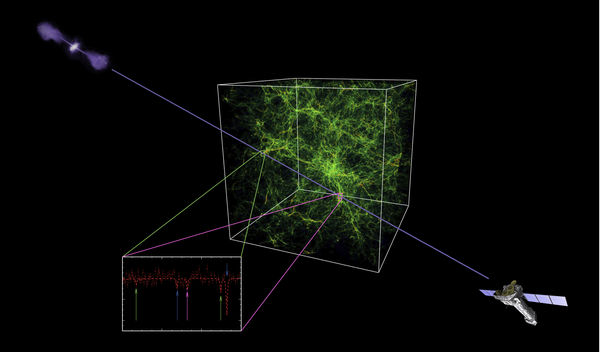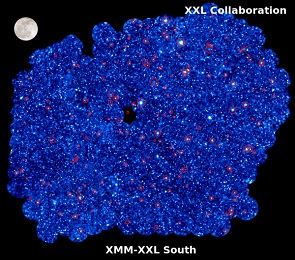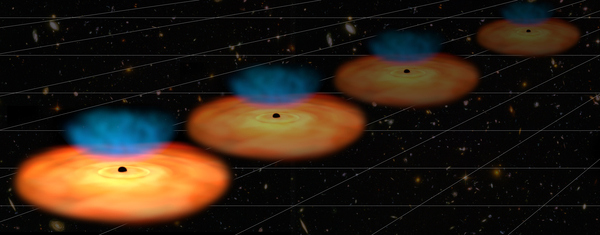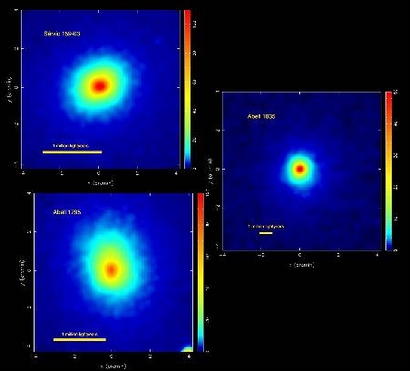XMM-Newton at 20: The large-scale Universe
9 December 2019
During its 20 years in space, ESA's XMM-Newton X-ray observatory has made many exciting discoveries. But no one could have predicted that the very first observation of the spacecraft would be one of its most important.At the turn of the century, astronomers thought that the gas found in clusters of galaxies – the largest objects in the Universe bound together by gravity – would be shedding energy and that large 'cooling flows' of gas should be giving out X-rays. These were among the first targets for XMM-Newton but the data showed none of the expected cooling flows.
It was a puzzle that was only solved some years later by a separate XMM-Newton observation involving active galaxies.
In active galaxies, the supermassive black hole at the centre of the galaxy is feeding at a sustained pace onto the surrounding matter. As the matter spirals towards destruction, it heats up and gives off X-rays. XMM-Newton detected ultrafast outflows of hot gas coming from active galaxies in clusters, which would heat the diffuse gas pervading the space between galaxies, explaining why there were no cooling flows.
"This had one of the biggest impacts of any XMM-Newton observation," says Norbert Schartel, ESA's Project Scientist for XMM-Newton.
Prior to that, clusters of galaxies were thought to be completely independent from the active galaxies they contain, but ESA's flagship X-ray observatory showed that the behaviour of galaxies affect the size, shape and evolution of the clusters.
XMM-Newton also resolved a twenty-year-long puzzle related to 'missing' matter in the universe. Astronomers had been having trouble locating all of the 'ordinary' matter.
Stars represent only about seven percent of ordinary matter in the Universe. The rest is gas. But almost half of this gas had eluded astronomers' ability to detect it until XMM-Newton. A 2018 study 'found' the gas located in intergalactic space. It had not been seen before because it was an extremely diffuse gas at a temperature of around a million degrees centigrade.
 |
| Detecting the warm-hot intergalactic medium. Credit: Illustrations and composition: ESA / ATG medialab; data: ESA / XMM-Newton / F. Nicastro et al. 2018; cosmological simulation: R. Cen |
Clusters of galaxies play a dominant role in another groundbreaking XMM-Newton study. The XXL project of 2015 was the largest XMM-Newton observing programme to date. It mapped galaxy clusters back to a time when the Universe was just half of its present age, and it confirmed a mystery – or tension, as astronomers like to call it.
 |
| XMM-Newton image of XXL-South field. Credit: ESA/XMM-Newton/XXL survey consortium |
When the team analysed the data from XXL they found that the density of clusters was lower than expected from our current understanding of the Universe, based on state-of-the-art cosmological observations and computer simulations. An important factor in the growth rate of clusters over cosmic history is how fast the Universe is expanding, and the XXL project result could imply that our Universe is expanding in a more complicated way than we currently think.
Indeed, when astronomers look at the very distant Universe they get one value for the cosmic expansion rate, yet when they look at the nearby cosmos they get a different value. XMM-Newton may be able to play a part in resolving this tension by looking half way between these extremes.
Using the observatory to target quasars, which are particularly bright active galaxies, astronomers have been measuring distances to probe intermediate epochs in the Universe's history. By surveying the quasars and deriving more accurate distances to them, XMM-Newton can bridge the gap between the different values of the expansion rate of the Universe.
 |
| Active galaxies to measure cosmic expansion. Credit: ESA (artist's impression and composition); NASA/ESA/Hubble (background galaxies); CC BY-SA 3.0 IGO |
"High-redshift quasars are a hot topic," says Schartel, "They are definitely something that we will be studying a lot more as the XMM-Newton mission continues."
For further information, please contact:
Norbert Schartel
XMM-Newton Project Scientist
European Space Agency
Email: norbert.schartel![]() sciops.esa.int
sciops.esa.int





